|
|||||
FlyingRC.net is a
Veteran-Owned site.

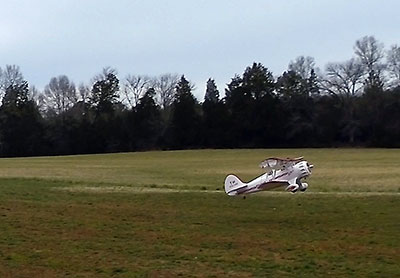 |
| The Phoenix Model Waco jumped into the air well before I expected. Click image to enlarge |
Phoenix Model Waco Maiden Day
Putting the giant, classic bipe in the air
Text, photos and video by Tom Hintz
Posted – 1-29-2019
The Phoenix Model Waco project took longer than I anticipated due to lousy weather and other work producing content for my sites. But, a predicted “decent” weather day in North Carolina gave me the chance to put the Phoenix Model Waco in the air. The actual weather turned out way different than predicted but I’m an RC’r so I maidened it anyway!
Getting Ready
As is my habit, I tried to have my new planes checked and rechecked before heading to the field. One of the last things I do is to be certain of the CG (center of gravity) before putting fuel in the plane. Using the CG tool included with the Phoenix Model Waco showed the CG to be perfect, eliminating having to reposition on-board equipment. I just had to finish securing the batteries and charging them up before pronouncing the Phoenix Model Waco ready to maiden.
Maiden Day
(1-27-2019) The weather prognosticators said we would have partly sunny skies, low to mid 50’s temperatures and little wind. The light wind part worked out, but the skies remained dim and overcast and I doubt the temperatures broke 50-degrees by much, if at all. Now more anxious than smart I decided to maiden the Phoenix Model Waco anyway.
I should note that the SoloShot 3 that shot the flight video was not having a good day, perhaps worsened by the dim light and solid overcast sky that helped the mainly white Phoenix Model Waco blend in with the clouds way more than is desirable for a trim flight. I will shoot a second flight day with the Phoenix Model Waco when better skies are available.
While assembling the Phoenix Model Waco at the field friends, Dennis and Rich, noted a twist in the (pilots) left wings. We were able to reposition the center wing section mounts a little and that reduced the twist, at least visually. One of those mounts also needed tweaking on one end which further reduced the twisting tension on the wings. I made a mental note to watch for an unwanted roll on takeoff in case the remaining twist had more effect than I anticipated.
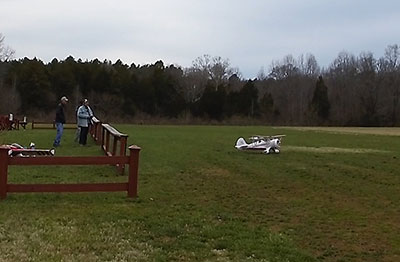 |
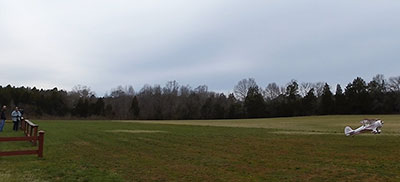 |
| I guessed right on the tail wheel steering (left) as the Phoenix Model Waco taxi's very well and runs straight at speed for take offs and landings. The first take off (right) happened before I expected. The radial has plenty of power! Click images to enlarge |
|
The last bit of preparation was to warm up the Saito 60cc Radial. I always warm my engines up before flying but give them a bit longer before a trim flight just to be sure. There are plenty of other things that can go wrong during a trim flight without rushing a cold engine.
First Flight
The first take off happened before I expected. I thought the 26.4-lb (dry) Phoenix Model Waco would need more runway/speed to take off but it was flying quickly. As soon as it left the ground, I could tell that the anticipated wing-twist roll was a non-issue. The only trims needed were a couple clicks of down elevator and 1 click left aileron. The Phoenix Model Waco was flying hands off soon after I made the climbing turn off the runway. I like this kind of surprise.
The only real issue noted during the first flight was that the Saito 60cc Radial was a little rich. Despite being down on power a little, it pulled the Phoenix Model Waco easily. I had a Vess 22C (about a 10-12 pitch) prop installed and while that seemed to work well, I will try a 23B Vess soon just to see if there is a noticeable difference.
A friend who also flies a Phoenix Model Waco had issues with a very slow roll rate. He wound up installing aileron servos in the top wing and that cured his problem. I had used HiTec HS-7954SH, 400+ oz servos in each (lower) wing driving both upper and lower ailerons and that apparently did the trick. My Phoenix Model Waco has a decent roll rate. It does not blur the wings by any means, but it does rotate faster than I expect a full-scale pilot would like.
My friend Dennis, who also took the Phoenix Model Waco sticks, and I both noticed that very little down elevator is needed as it passes through the inverted portion of an aileron roll. It also needs surprisingly little down elevator for inverted flight even though it flies straight and level at speed upright.
I always start shooting landing approaches early in a trim flight in case I need to land the plane sooner than anticipated. The Phoenix Model Waco is very steady at reduced speeds and glides much longer than I anticipated with a 26-pound bi plane. I
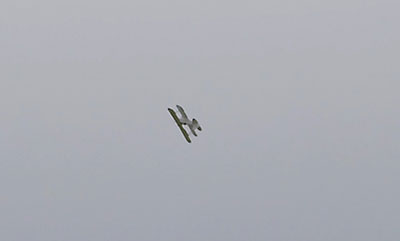 |
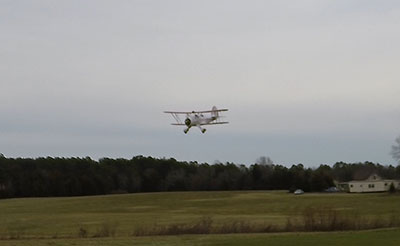 |
| A surprise was how little down elevator the Phoenix Model Waco needs when inverted, (left) even during a roll. The Phoenix Model Waco is very stable at all speeds including landing approaches. (right) This is a very easy plane to fly. Click images to enlarge |
|
had set up flight modes, one of which is for landing and found that one or two clicks of down elevator trim cured the tendency of the Phoenix Model Waco to “squat” as it approached the runway. Holding just a touch of up elevator lets the Phoenix Model Waco transition from flying to coasting down the runway without a bounce. It is very easy to land. It is important to resist pulling in up elevator as the Phoenix Model Waco rolls out as it wants to fly at much lower speeds than you might expect. Dennis found out that the Phoenix Model Waco recovers from an upright spin as soon as the sticks are released back to center. No over rotation or cross-controlling needed. The Phoenix Model Waco also has more vertical than we expected with the Saito 60cc Radial. The Phoenix Model Waco does very nice hammer-head stalls if you kick in the rudder shortly before it runs out of vertical momentum.
One thing I need to work on more is using the rudder. I tend to use the rudder a lot, including during landing approaches. I had the feeling that the Phoenix Model Waco wanted to drop a wing or at least begin that motion when rudder is applied at lower speeds. It is important to note that all the flights on day one were done with my “maximum throw” settings which could be contributing to heightened sensitivity. I will be exploring dual rates and expo in subsequent flights, particularly on the rudder.
Part of the next days at the field will be devoted to trying various dual rates to see if the Phoenix Model Waco has a control sweet spot. I am not expecting 3D maneuvers from this plane but want to be able to access its full flight envelope.
Conclusions
The Phoenix Model Waco is a great flying plane. Though certainly not a trainer, its solid handling and low-speed stability make this a good plane for RC’rs with moderate to advanced skills and the help of a qualified instructor to smooth the transition to a big bipe. This is a big, 26-pound plane so we must be even more conscious of safety.
The Saito 60cc Radial has more than enough power, providing what appears to be a somewhat larger than scale flight envelope. I was impressed at how responsive the controls are at the surprisingly low landing speeds. I get the feeling the Phoenix Model Waco will handle well right up to where it runs out of lift and falls to the runway so carrying just a bit of speed is best.
Video Tour |
Though not a screamer, the Phoenix Model Waco is faster than I thought. Factor in the sound of the Saito 60cc Radial engine and low, fast passes have a whole new dimension of cool. Another radial-related surprise was that this engine absolutely sips fuel. I suggested that Dennis land the Phoenix Model Waco as we had not yet looked at the tank to see how much fuel was burned off in a flight. It turns out that there was enough left in the 24-ounce tank for another two or three 7-minute flights.
The only negative aspect of this maiden day is that my friend Dennis is a bit disenchanted with me because I let him fly the Phoenix Model Waco. Now he wants one, and a radial engine. Life is tough, Dennis!
Resources
Phoenix Model Waco Build
Saito 60cc Radial Review
Have a comment on this Review? – Email Me!
All Flyingrc.net written, photographic and drawn materials are property of and copyright by Tom Hintz and Flyingrc.net 2013-2020 Materials cannot be used in any way without the prior written permission of the owner.
Privacy Statement


